Behind the wheel of the car, which instantly put Hyundai on the map of sustainable mobility. Ioniq can be electric, hybrid and plug-in hybrid. The aggressive price positioning on the German automobile market makes Hyundai Ioniq over 1,000 EUR cheaper than the Prius. But is it better that its role model?
2017 Hyundai Ioniq main highlights
- Ioniq is the first car in the world with three different green drive alternatives.
- Electric promises a 280-kilometer (174 mile) range – the first real traffic experience shows the approximate range of around 200 kilometers (124 miles).
- Hybrid version, armed with dual-clutch transmission, in real life require 4.6 liters of gasoline per hundred kilometers.
- Cheaper than Prius, in Germany the difference is 1,250 EUR.
- Plug-in hybrid comes in early next year.
Hyundai without excuses, a vision supported by reality
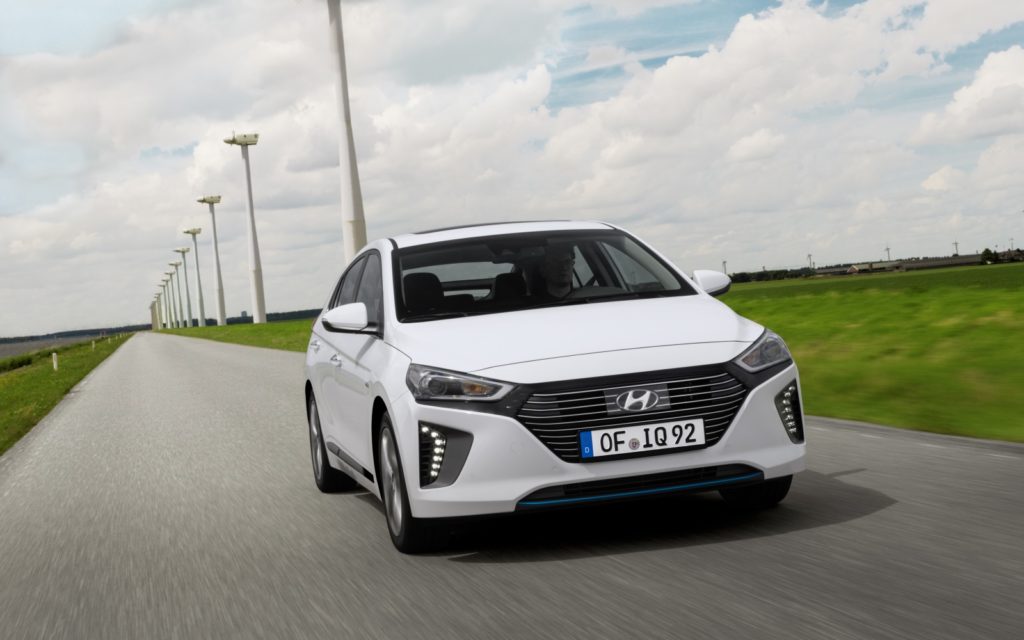
Hyundai Ioniq is the first car in the world with three different green drive alternatives.
2017 Hyundai Ioniq is or will be when hybrid and electric will be joined by plug-in hybrid at the beginning of next year, the first car in the world with three different electrical drives. The mere consideration of this determination says a lot of this Korean brand. No excuses, and long-term vision is after a long time backed up by reality.
Even so, confident predictions about the assault on the first best-selling Asian automobile brand in Europe should not be underestimated.
The key to success – commercial success of the hybrid
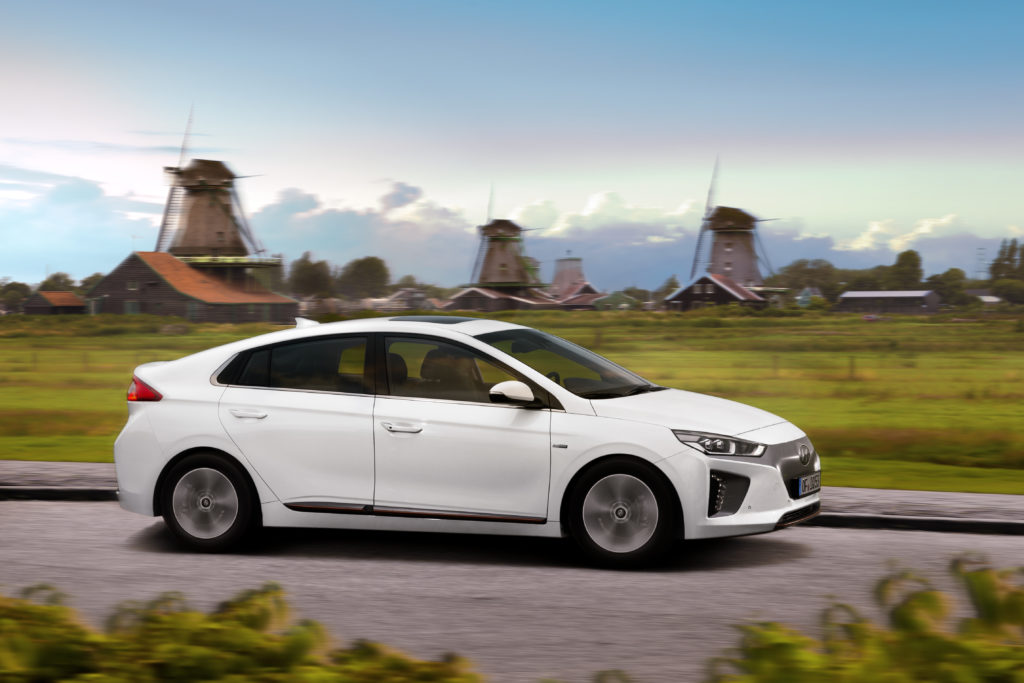
Battery powered 2017 Ioniq promises an all-electric range of 280 kilometers.
Hyundai Ioniq is here, and taking trends into account, customers will find the most advantages in the hybrid version. Even his appearance at the far reveals that the inspiration is gained through strict adherence to the air flow movement. This means that Hyundai Ioniq will not get rewards in terms of aesthetic, due to the very high rear end and the split rear window (a specialty well known to Prius drivers).
In the cabin, the Hyundai resorted to predominantly moderate design solutions. The dashboard, including a transparent layout of switches and after the first feeling good ergonomics, looks very traditional. In comparison with direct competitors appears less modern. Which does not mean anything for the overall quality of work, considered to be at a high level.
Petrol heart of Hyundai Ioniq hybrid – engine, which tied the record in thermal efficiency
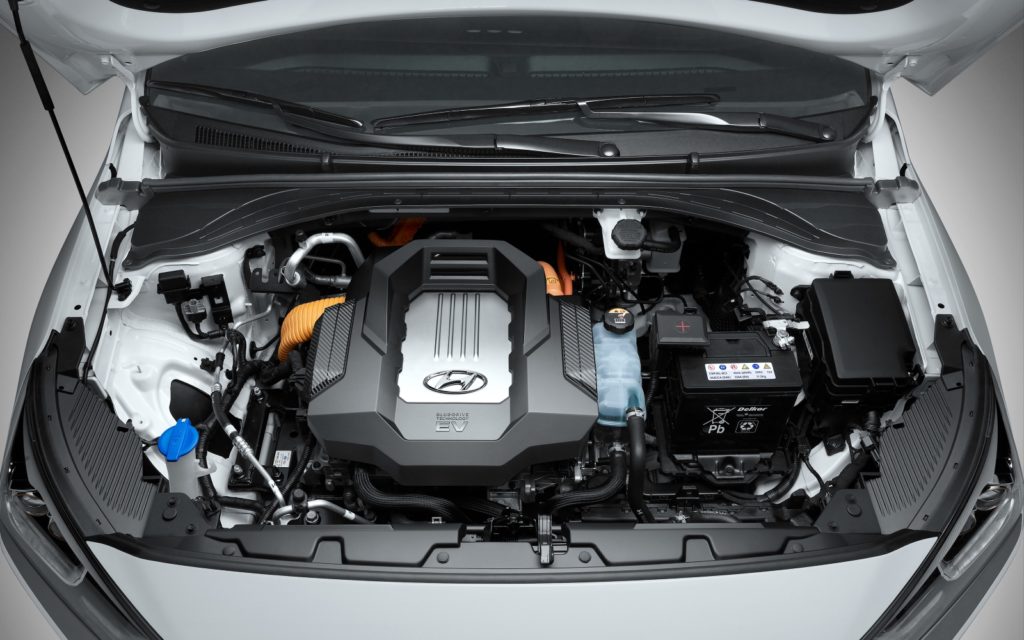
With 40 percent engine’s thermal efficiency, Ioniq ties the record value of the Prius.
Powertrain with a total power of 104 kilowatts (141 HP) is composed of a synchronous electric motor with a permanent magnet, with the maximum power of 32 HP and maximum torque of 170 Nm, and gasoline engine with a cubic capacity of 1.6 liters (105 HP, 148 Nm of torque), which operates on the Atkinson cycle. With amazing 40 percent thermal efficiency, Ioniq ties the record value of the Prius.
Engineers have opted for a lithium-ion battery, which compared with the nickel-metal hydride more efficiently handle the filling and emptying cycle. It has the capacity of 1,56-kilowatt hours, which in theory allows up to 120 kilometers per hour fast noiseless driving.
We have no doubt that Hyundai Ioniq really is capable of that, but only in truly optimal circumstances. Within the first test drive, the highest speed attained only by means of electricity was about 85 kilometers per hour.
CVT? What CVT? Dual-clutch gearbox!
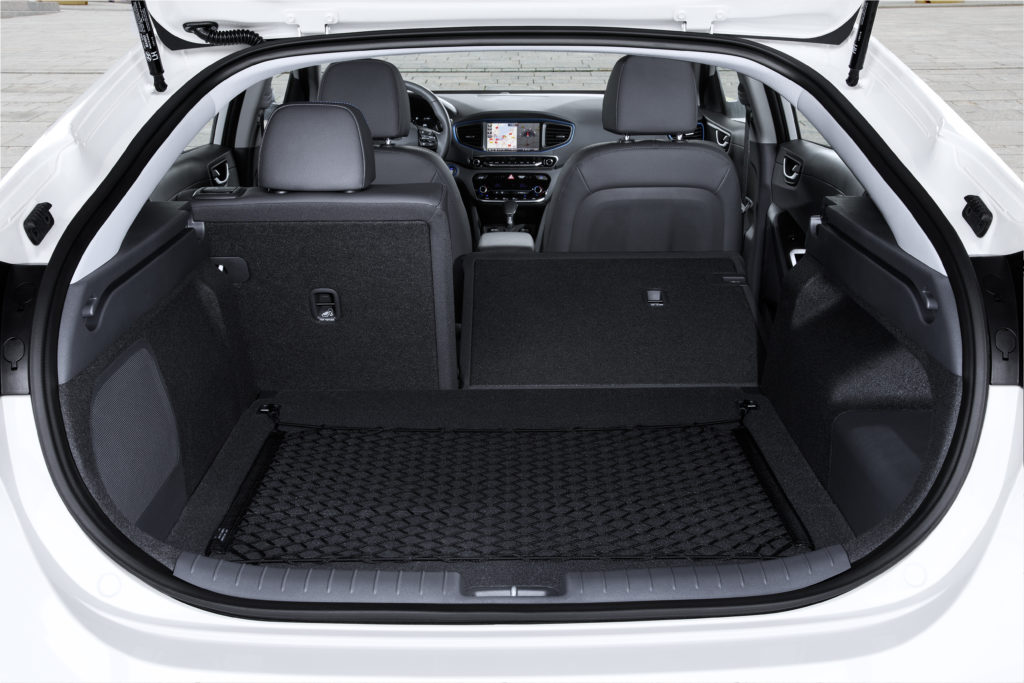
Hyundai Ioniq luggage compartment size: 350 / 1,410 liters (electric), 443 / 1,505 litres (hybrid).
About performance – an indication of 10,8 seconds to hundred kilometers per hour tells much less than the response times during overtaking, or just a simple urban driving. At the same time, we take into account that Hyundai, despite the established use of a continuously variable transmission in Prius, chose dual-clutch robotic gearbox for Hyundai Ioniq.
The experience is very positive. Firstly, because of the speed and responsiveness. And secondly, because of the fact that you are not forced to listen to the annoying sound of the CVT-product.
In terms of safety grown to the level of competitors
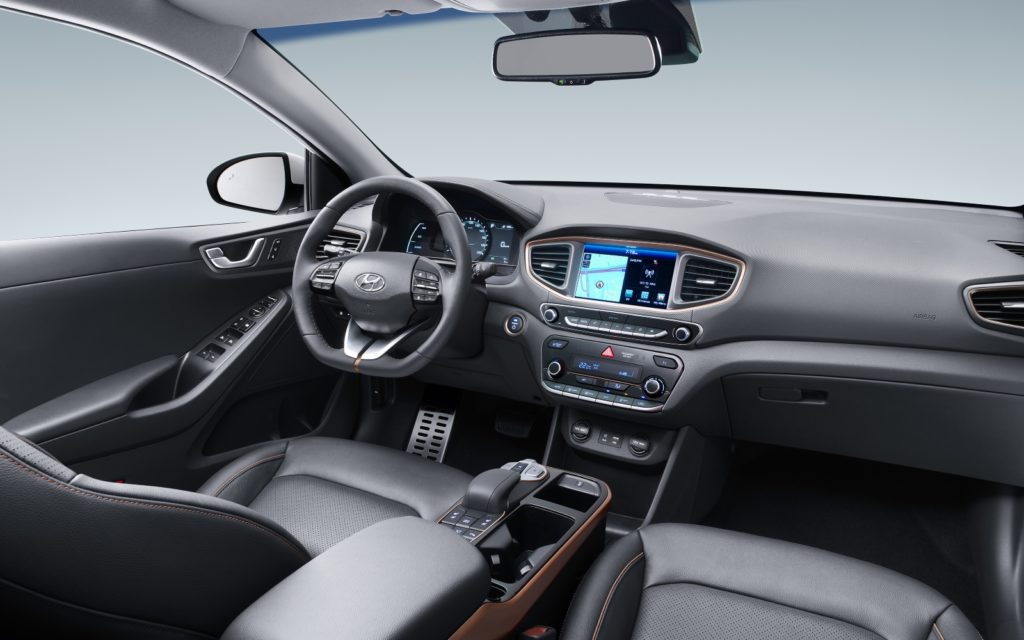
We don’t have to worry about the level of safety equipment, almost all is there.
Hyundai Ioniq will be fitted as standard with automatic braking in case of collision danger. Radars and cameras will not recognize only cars, but also pedestrians. The smart cruise control is serial. On the first run, it proved with loyal tracking of the vehicle in front, even in urban centers, interlaced with roundabouts. And after a full stop, Ioniq starts without driver incentives in the form of tapping the accelerator. Thank you, Hyundai.
Also serial is a system that keeps the vehicle in the driving lane. For an extra charge, among other things, Hyundai Ioniq offers the blind spot assistant and autonomous braking system in case of danger of collision when reversing.
What about electric Hyundai Ioniq?
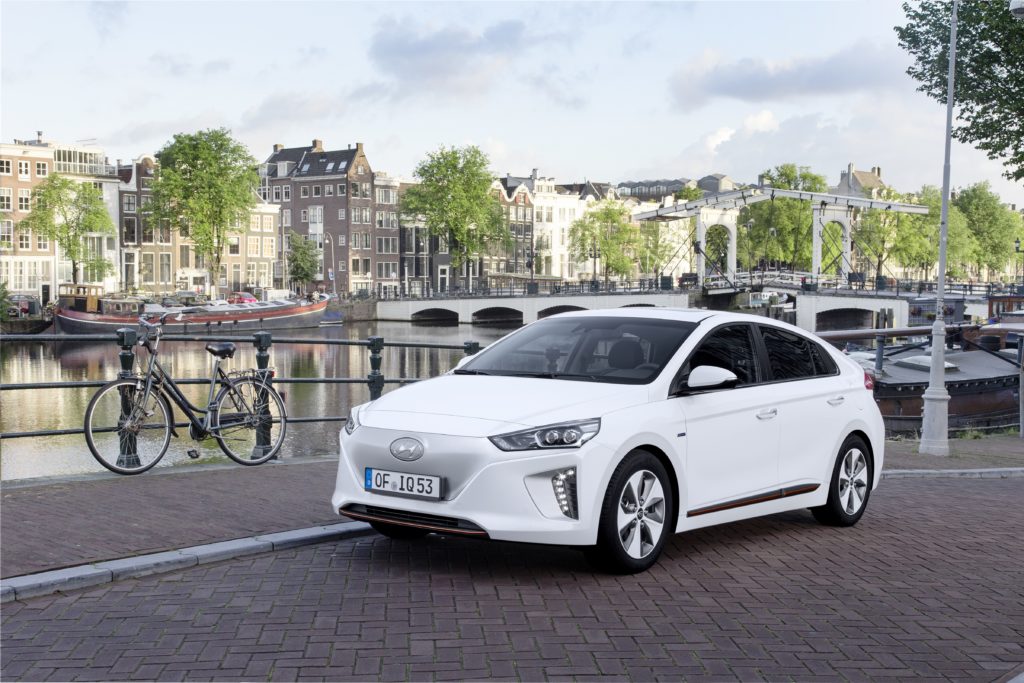
2017 Hyundai Ioniq will not get rewards in terms of aesthetic.
Everything, that is predictable about the electric Ioniq, is the name. All remaining proves the Hyundai determination in obtaining a green reputation as fast as possible. It will be powered by a synchronous electric motor with a capacity of 88 kilowatts (120 HP) and 295 Nm of instant torque.
The engine will be fed by a lithium-ion battery (installed under the rear seats) with a capacity of 28-kilowatt hours. Hyundai promises a consumption of 11.5 kWh per hundred kilometers or a total of 280-kilometer range.
The time will come for a thorough examination of the Korean promises, but on the first glance, the electric range meter on the dashboard deducted the remaining range numbers very slowly. Slow enough that we believe in at least 200-kilometer real life range. A figure, comparable to the Nissan Leaf or BMW i3 with a range extender. And the fact, that it boasts with the most favorable aerodynamic coefficient among aforementioned models (0.24), also helps.
Electric is more noticeable than hybrid – just look at the mask
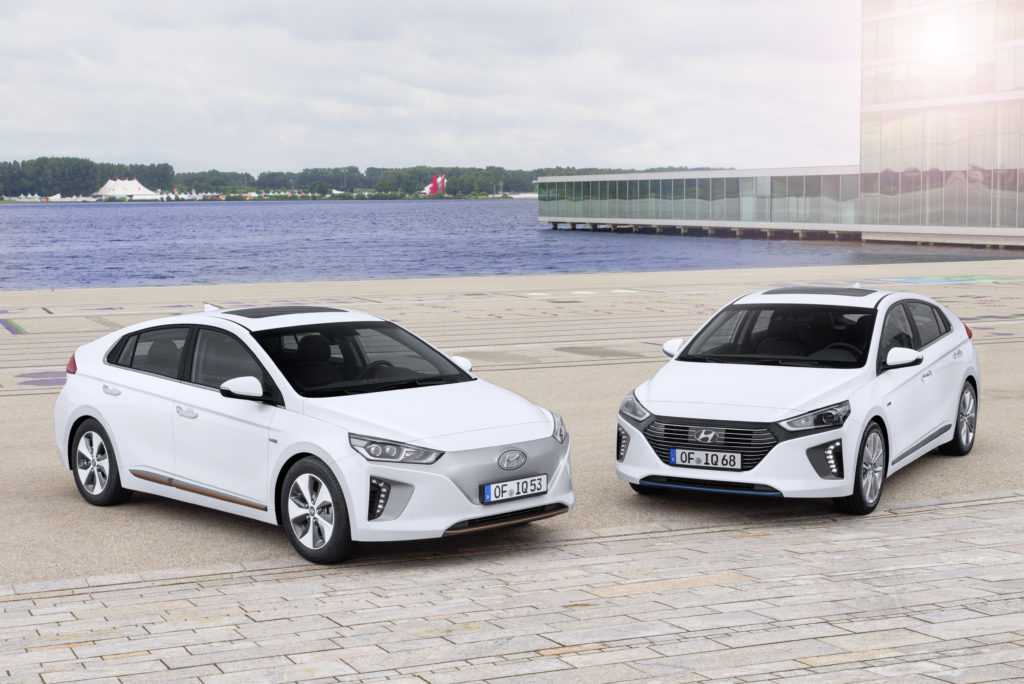
The difference between battery powered and hybrid Hyundai Ioniq.
Electric Ioniq differs from the hybrid also in appearance. Changes are not large but are highly visible. Mostly due to the closed outside mask, covered with a mat “silver” plastic.
In the cabin, instead of the traditional gear lever, there is a modern console with four large, reasonably named buttons – D, N, R and P. The cabin of electric Ioniq can be furthermore identified thanks to the different decorative trims in copper color.
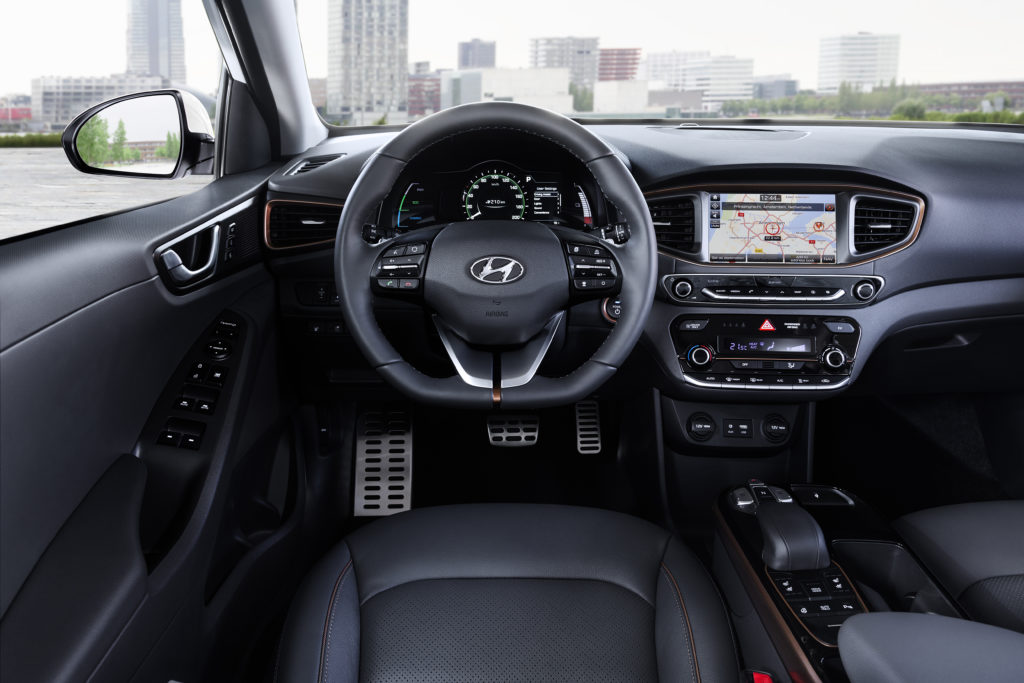
The cabin of electric Ioniq can be identified thanks to decorative trims in copper color.
We praise an ingenious way of a restructuring the steering wheel pads, which are usually used to shift gears in vehicles with automatic transmissions. In the case of Hyundai Ioniq, the purpose of these pads is to regulate variable regenerative power when braking and in the moments when the driver steps on the accelerator.
The system is a three-level adjustable and everything you need to know is that the most aggressive third stage acts and feels like an automatic braking, in case you withdraw your feet from the accelerator pedal. Interesting feeling, that will certainly come in handy. But in most cases, the car (like BMW i3) brakes by a relatively high intensity. Once you get used to this, there are no problems.
Is Hyundai Ioniq cheaper than Toyota Prius? In Germany, yes.
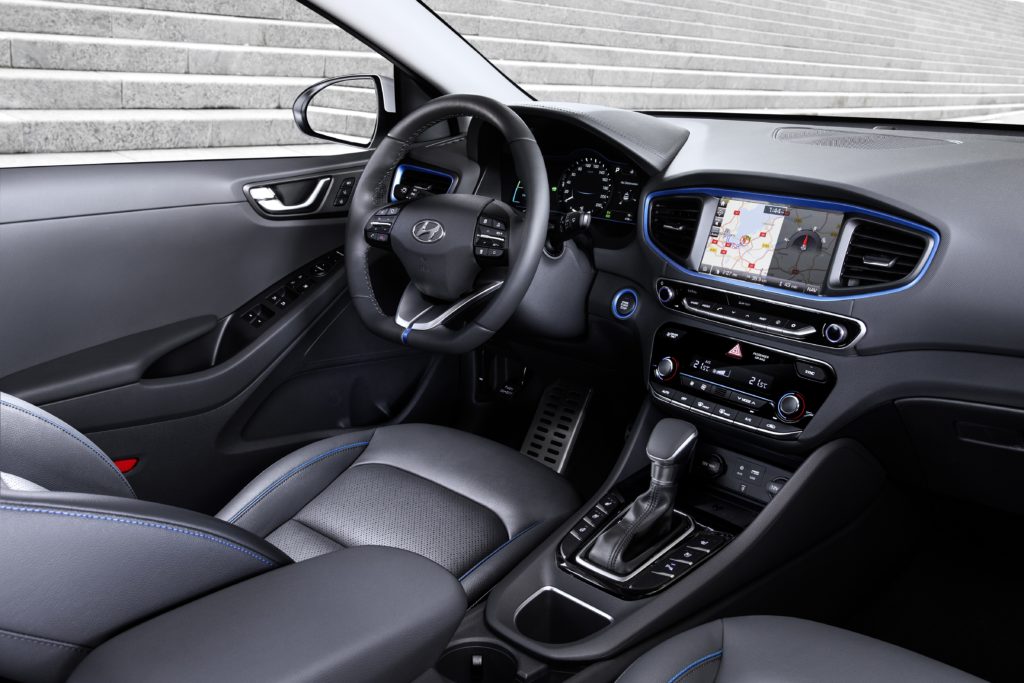
The price in Germany: 23,900 euros, or 1,250 euros cheaper than Toyota Prius.
Will Hyundai manage to make a major breakthrough with Ioniq? Since the technique and the quality of the product itself are not questionable, all depends on the price. Hyundai Ioniq Hybrid in Germany costs at least 23,900 euros, while the Toyota Prius requires at least 25,150 euros. Which is an excellent starting point.
The aggressive approach has certain advantages. But another thing that must be put into the account is the simple fact that Hyundai Ioniq is a complete novelty in the brand’s offer, which is still relatively inexperienced in this area. However, depending on the thoroughness of the approach, this is (almost) not noticeable.
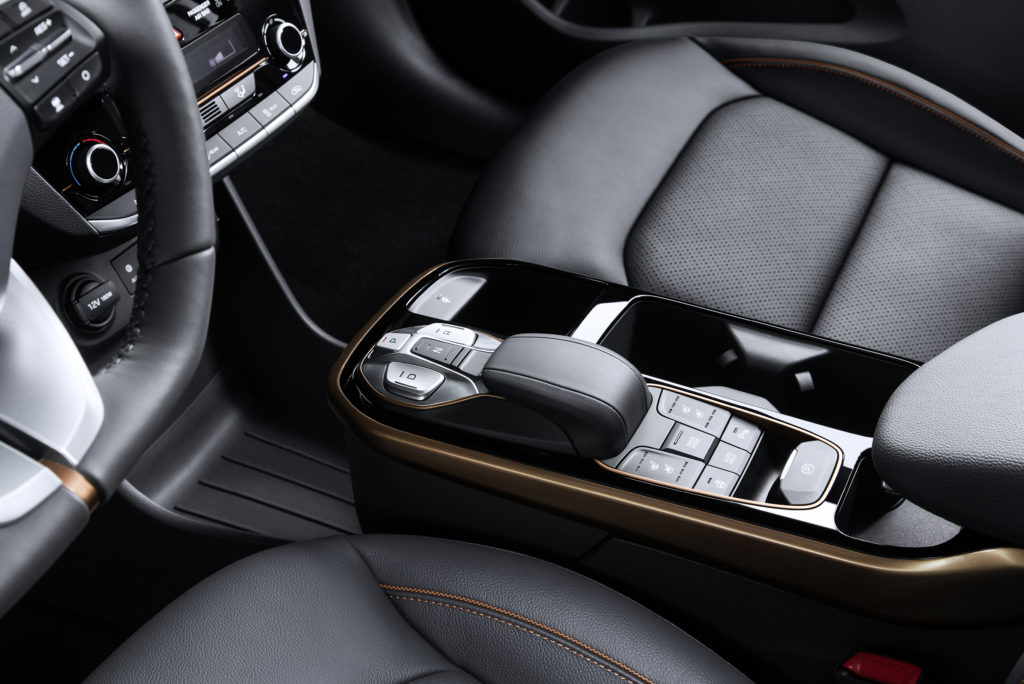
Hyundai Ioniq has 4 large, reasonably named buttons – D, N, R, and P – instead of a traditional gear lever.
Technical details: 2017 Hyundai Ioniq
Hyundai Ioniq Hybrid
- Powertrain: The 1.6-liter petrol engine, an electric motor with permanent gear.
- Consumption / emissions / efficiency: 3.4 l / 100 km and 79 g / km CO2.
- Performance: 10.8 seconds from 0-100 km / h.
- Price (Germany): 23,900 euros.
Hyundai Ioniq Electric
- Powertrain: an electric motor with permanent gear.
- Consumption / emissions / efficiency: 11.5 kWh / 100 km and 0 g / km CO2.
- Performance: 9.9 seconds from 0-100 km / h.
- Price (Germany): 33,900 euros.
Hyundai Ioniq Plug-in Hybrid
- Powertrain: an electric motor with permanent gear.
- Consumption / emissions / efficiency: no official data, goal is 32 g / km CO2.
- Performance: not available yet.
- Price: not available yet.
Dimensions:
- Length: 4,470 mm.
- Width: 1,820 mm.
- Height: 1,450 mm.
- Wheelbase: 2,700 mm.
- Luggage compartment / boot space:
- Electric: 350 liters, 1,410 liters with rear seats folded.
- Hybrid: 443 liters, 1,505 liters with rear seats folded.
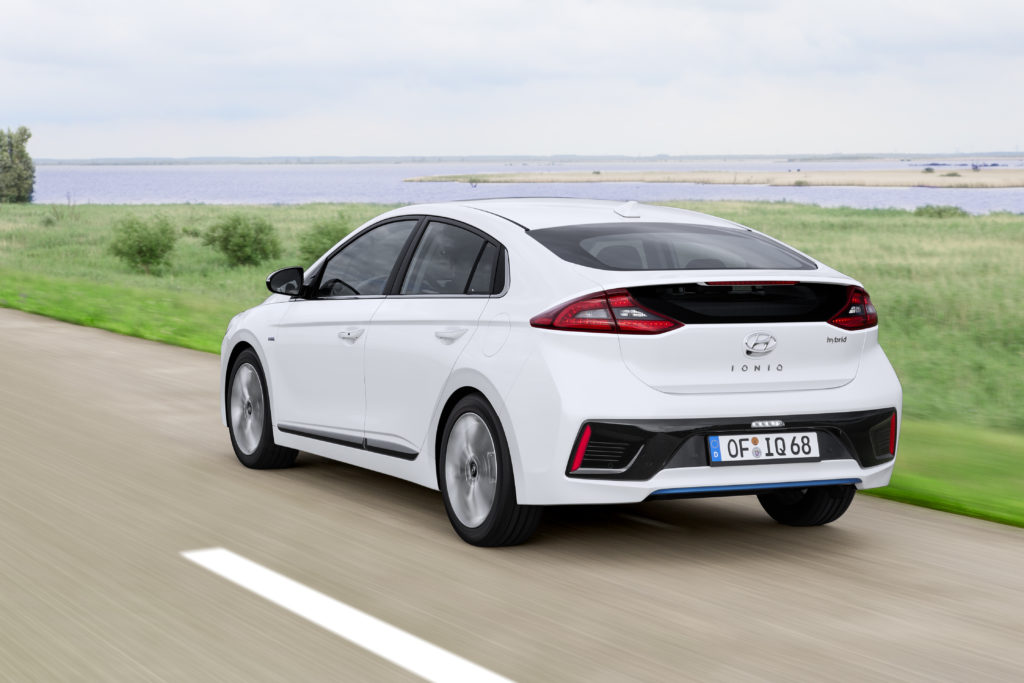
In reality, 200 kilometers of electric range is easily achievable. A figure, comparable with Nissan Leaf or BMW i3 with a range extender.
Hyundai Ioniq competitors and rivals
- BMW i3 (video comparison below)
- Chevrolet Bolt EV (video comparison below)
- Chevrolet Volt
- Ford C-Max Hybrid
- Toyota Prius (video comparison below)
- Kia Niro (video comparison below)
- Lexus CT
- Nissan Leaf (video comparison below)
- Opel/Vauxhall Ampera
- Volkswagen e-Golf (video comparison below)
Video comparisons: Hyundai Ioniq vs. rivals
Hyundai IONIQ electric vs Volkswagen e-GOLF (2017)
In this video, we compared Ioniq vs. VW e-Golf. Since 2017 e-Golf received a larger battery pack we wanted to show you what differences are between the two EV’s we believe will be huge competitors. Golf, of course, remains smaller in size (exterior dimensions and consequently interior dimension) and is still a lot heavier than Korean. Ioniq engine has now a little less horsepower under the bonnet but has a top speed limiter set a bit higher than e-Golf 2017.
Ioniq electric is able to achieve an almost identical total electric range with a much smaller battery capacity, all on the account of better energy efficiency. And the price comparison? In the USA, the price is in favor of Ioniq, but in Europe, Ioniq is cheaper. Interesting. See for yourself in the video below.
2017 Hyundai Ioniq electric vs 2017 Chevrolet Bolt
GM vs. Hyundai. Bolt vs Ioniq. Both cars are fresh, both with high expectations. And to be honest, not really comparable. While Ioniq is more family oriented with “normal” performance and a larger boot, Bolt looks more in the Tesla performance direction. Although the top speed is limited earlier than Ioniq’s, Bolt accelerates much faster and can travel much longer distance on a single charge.
Hyundai Ioniq electric vs. Nissan Leaf
Fresh EV wind versus established bestseller. Ioniq vs Leaf. Technically speaking, the difference is rather small, but in favor of the newcomer. The biggest advantage Leaf has in this comparison in the lower price.
2017 Hyundai Ioniq hybrid vs. 2016 Toyota Prius
A tough battle between the Korean and Japanese, Prius vs Ioniq. Both cars are approximately the same size, with similar petrol and electric motor. No big difference in performance or fuel consumption. Prius has a bit larger cargo volume, but again, nothing to brag about in front of Ioniq. The decisive factor could be the price (in favor of Ioniq) or the reputation (in favor of Prius).
Hyundai Ioniq hybrid vs. Kia Niro hybrid
Sharing the same powertrain, these two Koreans are strongly connected. Although Ioniq has slightly better performance, Niro represents the increasingly popular SUV / Crossover vehicle class. Overall, the small difference in price should not play an important role. Ioniq vs Niro? Tied.
BMW i3 (94 Ah) vs. Hyundai Ioniq electric
Similar as with the Ioniq vs. Bolt comparison above, the decision between Ioniq vs. i3 must be made based on your lifestyle. If you need 5 seats, it’s Ioniq. If you need more luggage volume, it’s Ioniq. But if you want to accelerate faster and enjoy while driving, it’s i3. Simple.
Hyundai Ioniq electric vs. Renault ZOE 40
Ioniq vs Zoe. Renault Zoe is cheaper and with longer total range. But Ioniq is larger, more spacious and faster. Target audience might be quite different here. Why not having both?
2017 Hyundai IONIQ electric vs. 2017 Mercedes-Benz B250e
We don’t know if it’s just our feeling or Mercedes is in a way almost hiding it’s EV model. Anyway, we found it and compared it. The result is below, Hyundai Ioniq vs Mercedes B250e technical comparison.
Ioniq is longer and lighter, Mercedes B-Class electric is taller. On the inside, these two offer similar space for passengers, but you can take more luggage with you in Mercedes-Benz. The motor power and acceleration is strongly on the German side, while Ioniq electric easily beats electric B-Class in energy efficiency. With the same battery capacity, Ioniq has 60 kilometers / 37 miles longer total range (on a single charge) and is also much more affordable. And maybe here is the answer to our question about hiding, who knows.
Image credit: Hyundai
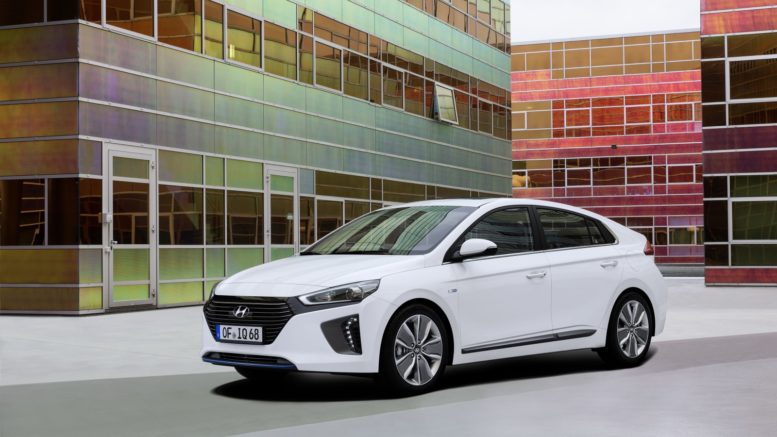

The only let down are the brakes, not in the power that they offer, but rather the inconsistency of the pedal’s response as the car tries to harvest energy for the battery. It’s a problem that afflicts many hybrids, and while better than most, the Ioniq isn’t perfect.